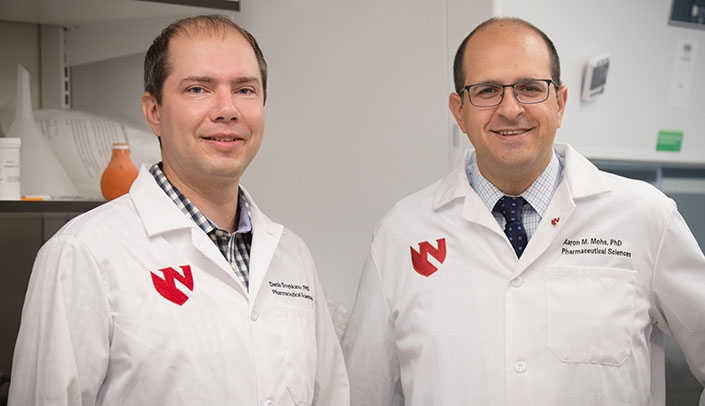A team of UNMC investigators has come up with a rapid, novel way of identifying and analyzing bacterial pathogens through the use of fluorescent dyes.
The method shows great promise in the potential to perform in the research and hospital settings, and even under harsh conditions in the field.
That’s huge, because quickly identifying bacterial pathogens is crucial to public health. And, that would be a new direction in the technology, as most current methods are slower, require expensive specialized equipment and are limited to lab settings.
The breakthrough?
“It’s a combination of organic chemistry, spectroscopy, microbiology, statistics and machine learning,” said Aaron Mohs, Ph.D.
The dyes tell the story of what’s in a particular sample through careful reading of colors and patterns. Denis Svechkarev, Ph.D., likens it to a “chemical nose.”
And, “Not only yes or no,” Dr. Svechkarev said. “But we also can ask diagnostic questions. What’s in the sample, and how much?”
Each pathogen has its own specific dye “fingerprint.”
Dr. Mohs, associate professor of pharmaceutical sciences, serves as principal investigator. Marat Sadykov, Ph.D., assistant professor of pathology and microbiology, and Ken Bayles, Ph.D., professor and associate vice chancellor for basic science research, also serve significant roles.
But Dr. Svechkarev, a research instructor in Dr. Mohs’ lab and a co-investigator on the project, is the one who designs and makes these special dyes.
Dr. Svechkarev said, “Our advantage is, we are using multiband fluorophores. We can get more information about their microenvironment and can obtain more reliable data.”
The next step the team is pointing to is “the translational stage,” Dr. Mohs said. This includes expanding the possible panel of dyes, in order to achieve an even more specific analysis of complex mixtures. And, to look for ways to turn it into a device accessible to the medical/scientific community at large.
This invention would not completely replace the current technology of sending samples to a lab. But, for entities such as rural clinics or in-the-field defense forces, it will provide rapidity and accessibility.
The project is funded by a four-year, $1.3 million R01 National Institutes of Health grant. The team recently published its latest findings in the journal ACS Sensors.

Dr. Mohs and Dr. Svechkarev, Congratulations on your successful achievements!
Keep up the good work! So glad to see this idea turned into reality!
Outstanding progress – well done!
Wow! how cool!
Interesting work!
Impressive!
This is awesome news! Great work!